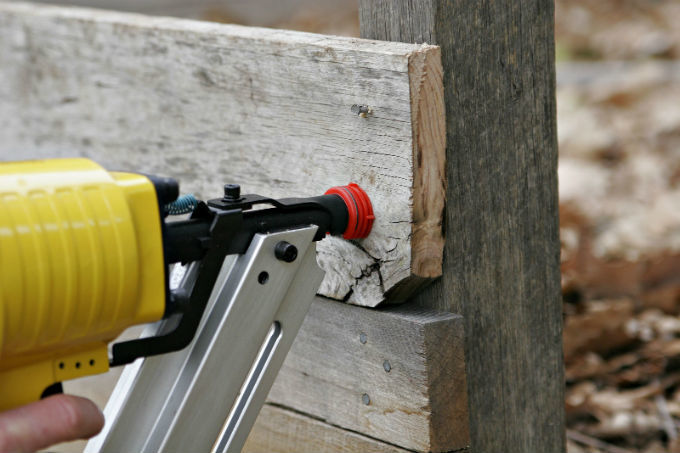
The pneumatic nail gun is the answer to one of the carpenter’s most pressing onsite problems: how do you nail hundreds of nails quickly and consistently?
Driving nails and fasteners is such a time consuming (yet essential) task that manufacturers have basically built specific nail guns that are suited for most nailing applications. From tiny furniture pin nails to large framing nailers, there’s a nail gun made for the task.
The Pneumatic Nail Gun, Versus Cordless Nailers
You will find contractors that swear by their pneumatic, air-powered nail gun just as often as you will find those who prize their battery powered nailers. It’s an age old debate that’s mostly been settled thus: use the best one for the project and site conditions. That said, there are some clear advantages to the pneumatic nail guns that cordless nailers are only now beginning to match.
The main drawback to opting for a pneumatic nail gun is, of course, the need to have an air compressor to use it – as well as the inconvenience of an air hose that comes with that.
Once you get over that disadvantage, you will find the heavy duty nail gun to be a reliable tool with little in the way of complex parts and circuitry that can go wrong.
Framing nailers, for example, are very energy intensive devices that will quickly wear down a battery, especially as the carpenter nails hundreds of large fasteners in the course of laying out a house frame or a deck. As the cordless nailer has the deal with the downtime of swapping out batteries and charging them, the pneumatic nail gun user is working uninterrupted putting in nail after nail.
How to Choose The Right Type of Pneumatic Nail Gun
With an entire range of pneumatic nail guns on the market today, you will be spoiled for choice when it comes to choosing a nail gun for your next project.
There are general purpose nailers used in a wide variety of onsite tasks like framing, as well as workshop project stages like adding finishing panels. On the other hand, there are some pneumatic nail guns custom designed for certain tasks – roofing, flooring and siding, to name a few.
General Purpose Pneumatic Nail Guns
If you are looking to be more effective in the workshop or on the job site by rounding out your power tool collection, you can’t go wrong with investing into one of these general purpose nailers to get you started with a wide variety of nailing tasks.
General purpose nailers cover everything from the heavy duty framing nailer, the mid-range finish nailer, the smaller brad nailer and the detailing pin nailer.
Pneumatic Framing Nailers
For heavy duty work that requires working with structural posts and beams, the pneumatic framing nail gun is the heavy duty tool you need.
These are the ones that can drive large nails into soft or hard wood thousands of times a day without fault and some of the largest models out there today.
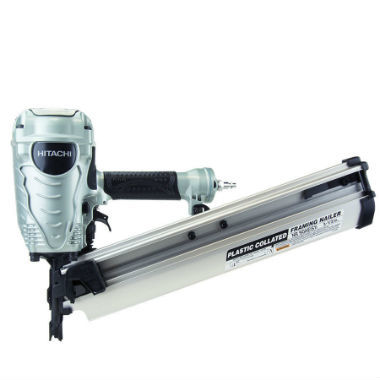
hitachipowertools.com
Features to Look For in Pneumatic Framing Nailers
- Large triggers will help you a lot in controlling the tool accurately.
- Air hose swivels are always a thoughtful feature that lets you reduce air hose tangles by letting you shift the air hose any direction you need to. Especially useful while reloading the tool, or when navigating through the maze of house framing you are working in.
- Directional exhaust features lets you adjust the direction of the outbound air which is helpful in certain situations.
- Jam clearing features keep you productive by letting you clear nail jams caught in the loading mechanism quickly which is one of the downfalls of using a framing nailer.
They are suited for framing houses and will take a wide range of nails (8d and 16d being the two most common types).
Framing nailers are useful outside of the house as well. Building decks and sheds, installing fences and other outdoor structure can always use a pneumatic nail gun to speed things up a bit.
Pneumatic Finish Nail Guns
Pneumatic finish nailers are the next step down in terms of the size of the nail that they use, for a general purpose nail gun at least.
The usual finish nail gun are designed for the smaller and more popular 16-gauge nails, although some nailers can also take the bigger 15-gauge.
Finish nailers are an essential tool for professionals who do extensive home remodeling projects (mainly finish type of work) and are also popular with furniture projects too.

bostitch.com
The nails used by a finish nail gun are sturdy and long enough to fasten larger pieces of wood, while remaining small and easy to hide with a coat of putty later before putting on the final finish.
Features to Look For in Pneumatic Finish Nail guns
- Drive depth adjustment features will let you adjust the depth that the nail will drive into the material.
With the appropriate settings, you can set the nail gun to leave the nail head sticking out, drive them in flush, or even countersink them. - Exhaust features that can drive dust and debris away from the work piece can minimize clean-up later.
- Blunt, smoothed or cushioned nose tips help to avoid marring the wood.
- Lightweight models let you wield the tool more deftly and accurately.
- Integrated lighting illuminates the target area, helping you aim for your marks more accurately (helpful on cabinetry).
What They Are Typically Used For: Pneumatic finish nail guns are well suited for remodeling jobs like installing crown molding, baseboards, chair rails, paneling and millwork.
Some types of hardwood floors are also designed to be installed by finish nailers. In the workshop, the finish nailer is the best tool to nailing together cabinets and furniture consistently and efficiently.
Pneumatic Brad Nail Guns and Pin Guns
Pneumatic brad nailers are best suited for fine woodworking projects like installing thin panels and inlays, where there is a risk of larger nails may end up splitting the wood.
Brad nailers use high-gauge nails, at least 18 or smaller – these tiny nails are difficult to handle by hand, and a power tool is about the only way to nail these in quickly and efficiently.
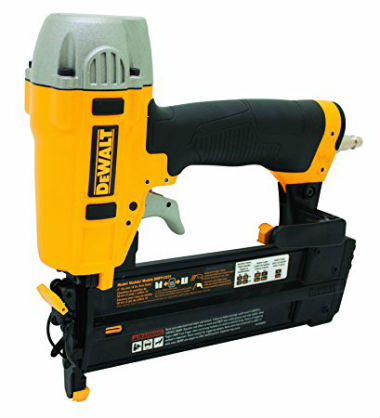
dewalt.com
Features to Look For in Pneumatic Brad Nail Guns and Pin Guns
- High magazine capacities will increase your productivity.
- Lightweight models with anti-slip grips make the tool itself comfortable to handle.
- Various nail sizes, along with a depth adjustment feature lets you switch to smaller or larger brad nails quickly as needed.
Brad nailers, like the even smaller pin nailers, are well suited for small scale woodworking projects like building birdhouses or assembling wall frames. They are also used for securing thin pieces of wood and veneer.
Pin nailers are great for attaching small moldings that would otherwise crack with larger nails or brads. Unlike other nail guns, pin nailers are designed to drive headless pins that leave tiny, almost imperceptible holes.
Pneumatic Nail Guns for Specific Uses
Some applications of the nail guns are so specific that manufacturers have designed and built nail guns for that purpose and little else. These specialized nail guns are often used by contractors whose expertise lie in flooring, roofing or siding.
These tools are designed to deliver consistent results for jobs where precision is required – installing floors, attaching house siding or securing shingles.
Pneumatic Flooring Nail Guns
These flooring nailers are designed with just one purpose in mind: flooring installation. Some models are even more specialized for hardwood floors only – they have one job, and they do it really, really well.
Some flooring nail gun models are designed to be powered manually, the majority of floor nailers on the market, however, are the pneumatic type.
Pneumatic flooring nailers are simply more consistent in generating a larger force on the nail, which ensures a clean flush finish almost 100% of the time.
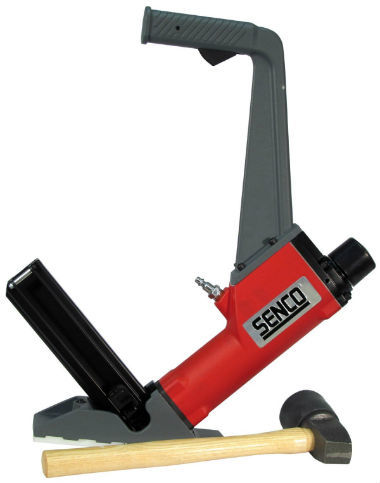
senco.com
Features to Look for in Pneumatic Flooring Nail Guns
- Stapler gun features allows you have two tools in one: a flooring nailer and a stapler gun. Some of the better models even come with separate magazines for both, letting you switch between flooring cleat nails and staplers seamlessly.
- Replaceable guards lets you easily replace the guards and guides on your flooring nail gun when they wear out, making the tool last longer.
- Easy access to oil ports and o-ring section lets you do maintenance quickly.
- Non-marring base plates will keep the hardwood pristine even as you quickly slide the tool on it from spot to spot.
Pneumatic Siding Nail Guns
Siding nail guns are really roofing guns but work well for siding mainly because of the nails they use. They use specific nails that are compatible with siding materials used today, like wood, vinyl and aluminum.
These nails do come in standard sizes, so theoretically, you can use a framing nailer as well if you had to but these are much better suited for the task.
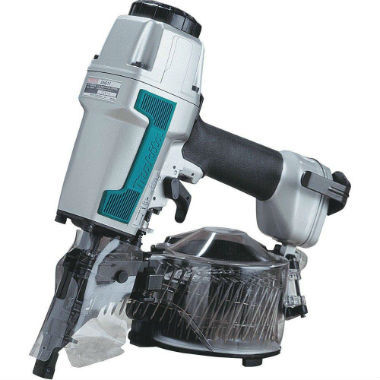
makita.com
Features to Look for In Siding Nail Guns
- Exhaust systems deflect vinyl and metal shavings away from the operator
- Some come with a hook that will attach to your tool belt, which is a good idea to keep the gun in reach.
- Accessories like googles, adjustment hex wrenches and a protective plastic case are great extras that keep the gun safe and organized.
Pneumatic Roofing Nail Guns/Staplers
Just like siding nailers, roofing nailers are specially designed for roofing applications.
Unlike siding nailers, though, there is really no substitute for a roofing nailer when it comes to working with shingles, especially those made of fiberglass, asphalt, or ceramic composites.
Each type of roofing needs a specialized type of nail or staple, and those are almost always designed to be used with a roofing nail gun.
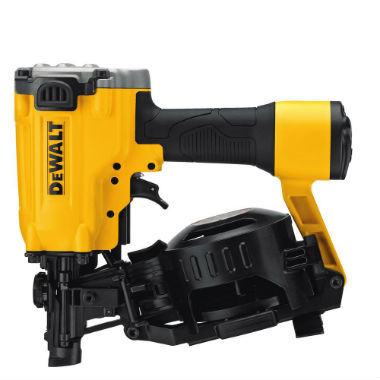
dewalt.com
Features to Look For in Roofing Nailers
- Visual nail capacity indicator lets you know if you are running short of nails for your current run of shingles. Installing roofing materials can take a lot of nails per pass, so it helps to know if you need to reload.
- Spacing and depth gauges help you space shingles accurately as you lay and nail them down with one step.
- Bump firing or sequential options lets you pick the firing mode of your nailer.
Pneumatic Nail Gun Safety
Just like other power tools, you need to pay attention to safety whenever you pick up a nail gun. Protective gear, especially for the eyes is a must when using a nailer.
Because nailers are also used to put together load carrying structures, make sure that you are using nails and fasteners that are compliant with your local building codes. Some areas, for example, do not allow the ‘clipped’ or D-shaped nails to be used in framing and other similar applications.
Make sure to use the right nail and nailer for the job – a good number of nail gun injuries are caused by the nail penetrating through the lumber.
Always read the manufacturer's guides supplied with your tool and get familiar with the trigger mechanism that your nail gun uses. If you need to clear a nail jam or reload, always disconnect the unit from the power source or air compressor first.
Keep your finger off the trigger while carrying a nail gun around.
Always check the area you are aiming at, and pay special attention as to whether there is a nail already embedded in there. A common cause of nail gun injury is from nails ricocheting off metal or concrete. Along those lines, always check aim a nail gun from a stable position so you never miss the work piece, which should always be secured in place.
Under no circumstances should you point a nail gun at a person or animal, and if you are up on an elevated surface, always make sure that the area below is clear of people and marked as a hazardous area.
Finally, never operate a nailer in conditions where a spark can set off suspended dust particles or gas.

